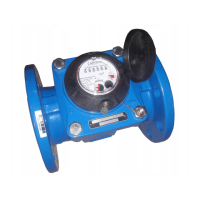Flanged water meters / flow meters, DN40-400-IP65/68-CE – Operating Manual
Page 9 of 19
A water meter that is too small overstresses the mechanism, resulting in premature wear of the moving
components.
For your water meter to perform properly within its measurement range limits and maximum indication error
limits, its operating range must be precisely determined, which can also be achieved based on monthly water
demand, considering the minimum and maximum volumetric flow values (for existing installations, it is
recommended to monitor the water supply).
It is recommended to choose a water meter size where the maximum foreseen volumetric flow of the system
is equal to the following:
• 0.5 to 0.7 of permanent flow rate Q
3
for type MWN (WPH-01) Nubis water meters;
• 0.3 to 0.4 of permanent flow rate Q
3
for type MWN130 (WPH130-01) water meters;
• Q
3
for the coupled water meters;
• 0.6 to 0.8 of permanent flow rate Q
3
for type MK-01 water meters;
• 0.6 to 0.8 of permanent flow rate Q
3
for type MH-01 water meters;
• 0.5 to 0.7 of permanent flow rate Q
3
for type JS Impero water meters;
The permanent flow rate Q
3
values for specific water meter types are listed in Table 3.
The application of the optimum water meter type also depends on the water temperature and pressure, the
conditions for water meter installation in the water supply pipe, and whether the indications and the
volumetric flow measurement values need to be output remotely or not. Another criterion for selection of the
water meter size is the pressure loss in the system caused by installation of the water meter.
Select a water meter such that frequent or prolonged flow rates are not within the operating range of the
spring-action switchover valve. The switchover operating ranges are shown in the specific Technical Data
Sheet.
5. Selecting the correct size of the irrigation flow meter
The proper selection of the size criterion (for DN, the nominal diameter) of the irrigation flow meters should
always depend on the operating conditions, i.e. the mean and maximum operating volumetric flow of water in
the pipe system to which the flow meter is to be connected rather than the diameter of the pipe. An irrigation
flow meter that is too large under actual operating conditions not only increases the purchase costs, but it
also reduces the water measurement indication accuracy when the water flow is low. An irrigation flow meter
that is too small overstresses the mechanism, resulting in premature wear of the moving components. For
your irrigation flow meter to perform properly within its measurement range and maximum indication error
limits, its 24-hour operating range must be precisely determined, although this can also be achieved based
on monthly water demand, considering the maximum volumetric flow values. The maximum permitted loads
of the irrigation flow meters are listed in Table 4.

